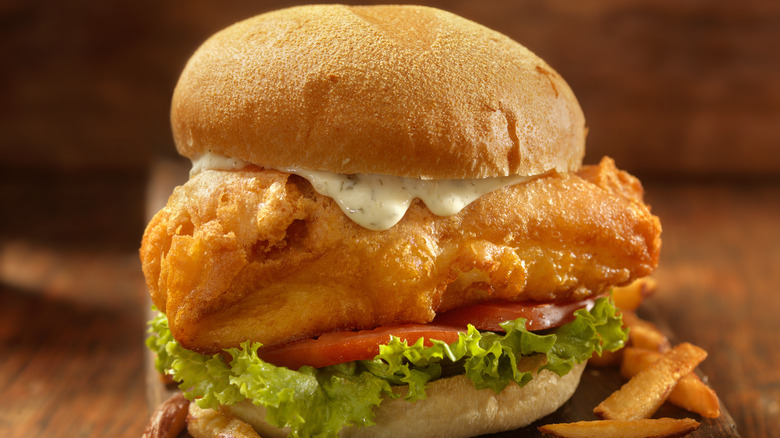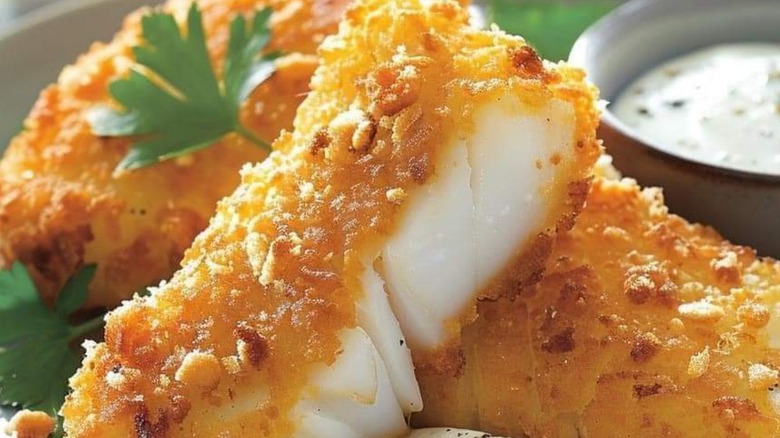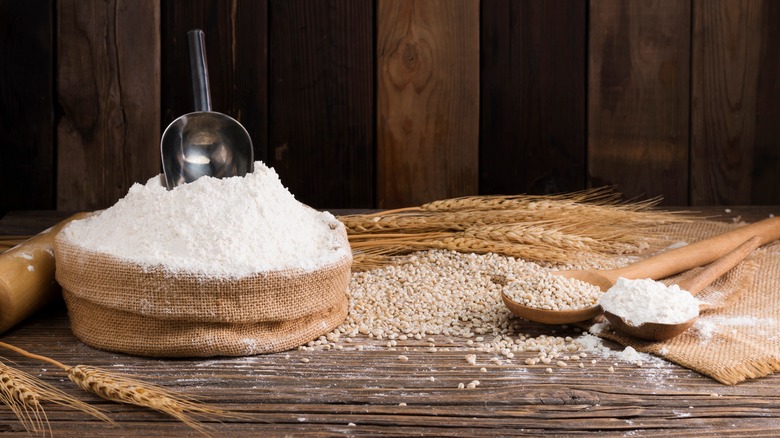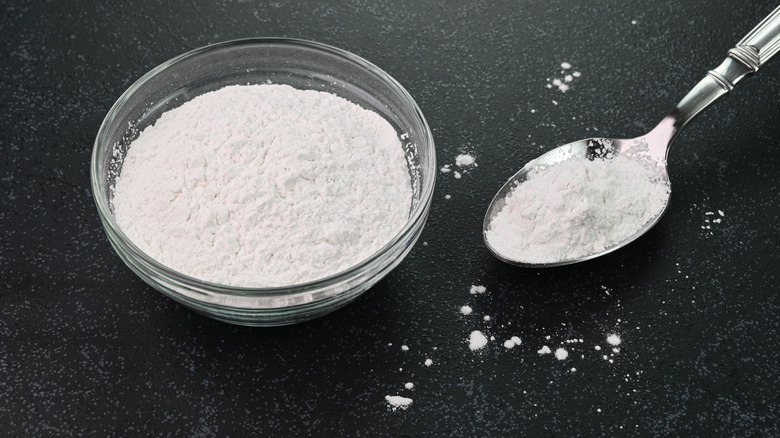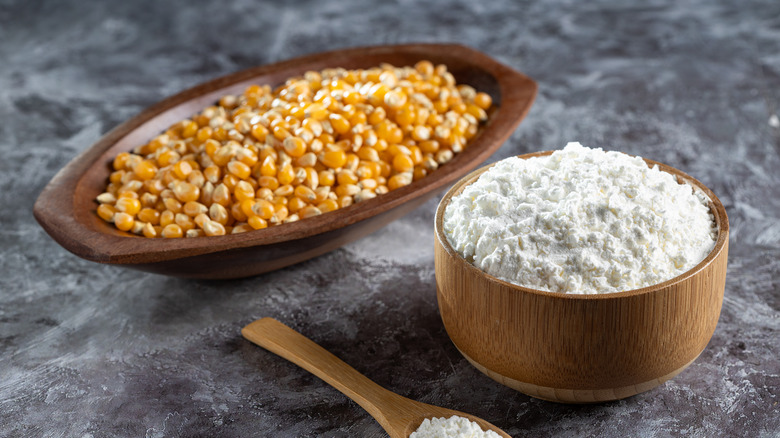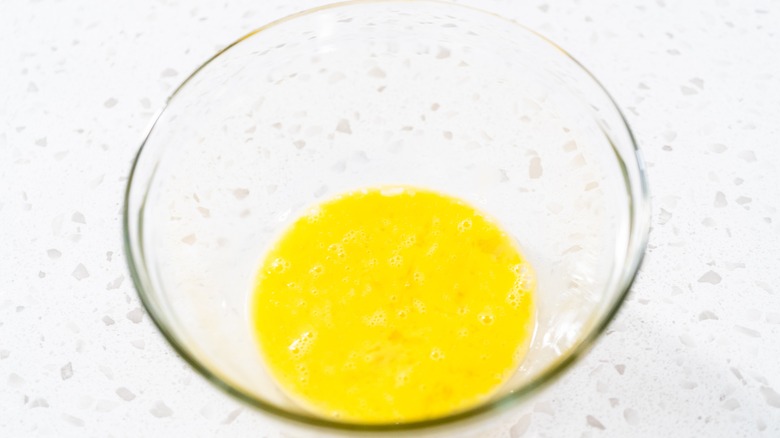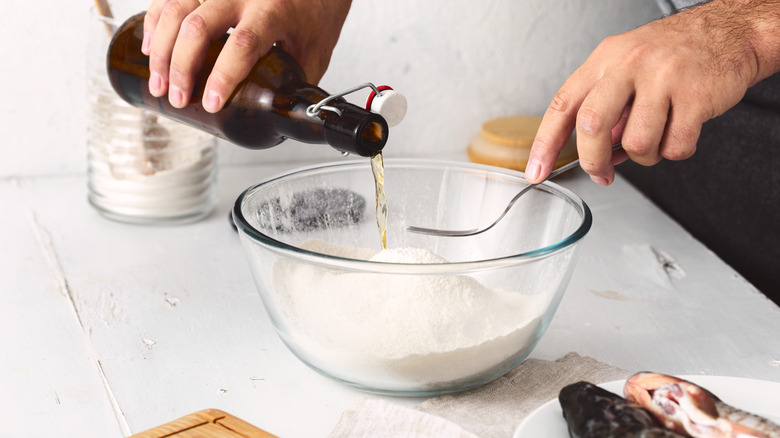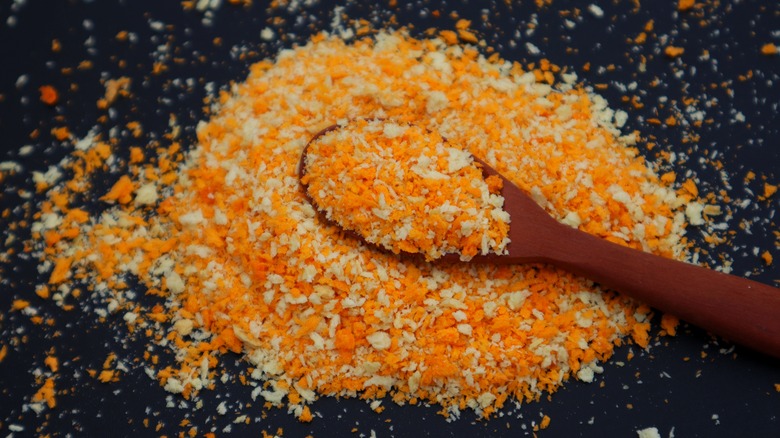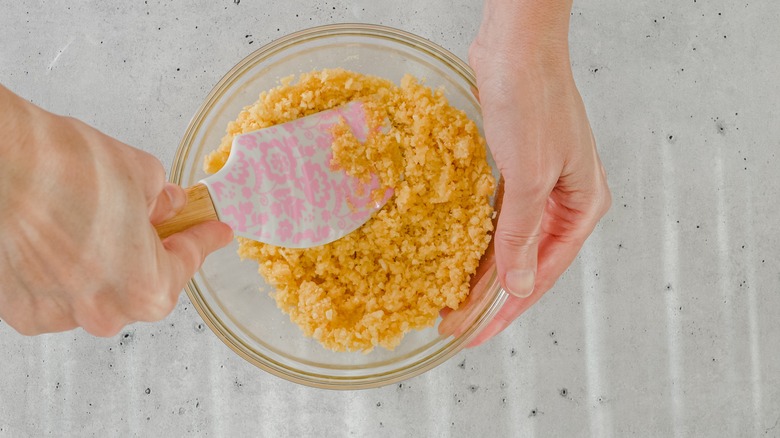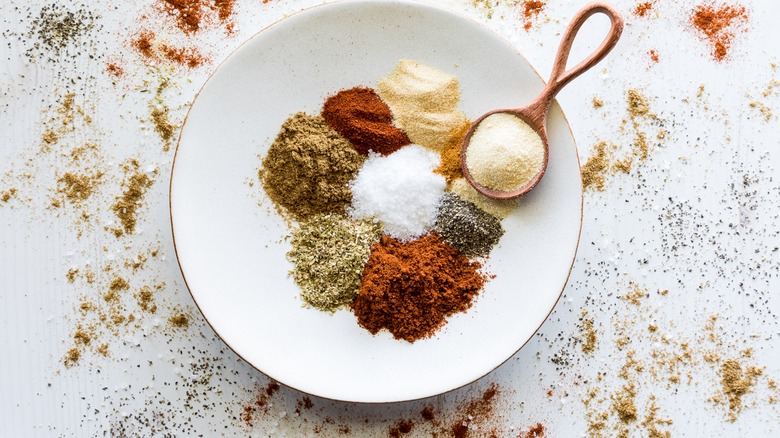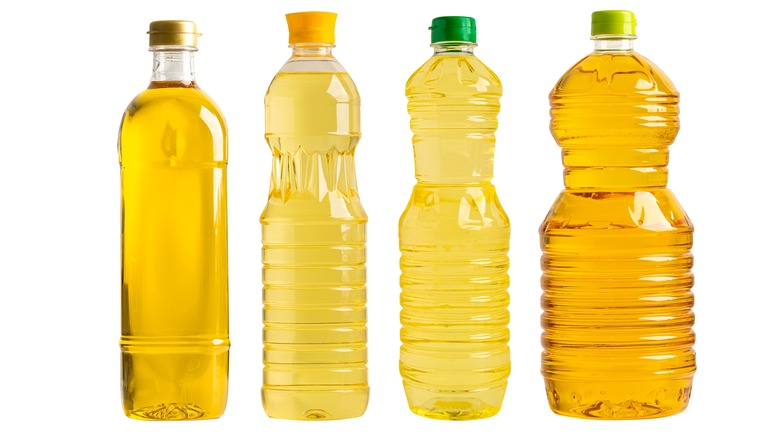10 Ingredients That Will Make Your Fried Fish Extra Crispy, According To Chefs
There is nothing more satisfying than the crunch of a super crispy piece of fried fish, whether it is the star of a seafood basket, sandwiched in a bun, or shining all on its own. On the other hand, it is super disappointing to bite into a soggy fish sandwich or have a plate of fish and chips that is distinctly lacking in crunchiness. It may seem effortless when ordering your fish at a pub or restaurant, but at home you'll learn that getting that coveted golden crust is a delicate dance of having the right breading, the right oil, the right frying technique, and the right timing — simultaneously.
"The key to a crispy fried fish is a balance of starch, flour, and a little crunch. If done correctly the coating will lock in moisture of the fish, while creating a crispy airy texture," says Chef Maricel Gentile, owner of Maricel's Kitchen in New Jersey and Chef Ambassador for K-Seafood USA. "We all have had when you bite into a well fried piece of food, and you just get the right crunch and moisture, and flavor all come together — that is what we are going for."
There is much to learn about achieving the perfect crispy crust on fried fish — starting with choosing the right ingredients. We spoke with some expert chefs to get the scoop on what you shouldn't skip when making your fried fish at home, and some mistakes to avoid so you'll get extra crispy fried fish every time.
1. Determine your fish's crunch
The first choice you need to make when making fried fish is what to coat it in. "'Breading' often includes a full coating with flour, egg wash and breadcrumbs, while 'dredging' is just the initial flour coating," says Rima Kleiner, MS, RD of Dish on Fish. Allie Hagerty food blogger and recipe creator at Seasoned and Salted says that when choosing between a batter or dry breading, you should consider the type of crunch you're looking for. "A batter will give you a thicker, crunchy coating (think fish and chips), while a dry breading gives you a thinner, crispier crust (think classic fried catfish). If you want something ultra-light, try a tempura-style batter with cornstarch and club soda," she says. "For a classic, crunchy bite, a flour and panko dredge is always a winner." But dredging isn't for everyone. "I'm not a huge fan of dredging, generally speaking, and we don't dredge our fish at The Darling either," Executive Sous Chef Monique Mickle of the Darling Oyster Bar in Charleston says. "I feel that there is too much breading when dredged."
You will also need to consider the type of fish, according to Maricel Gentile. "For delicate white fish, like cod or flounder, tempura-style batter is a great choice, while for heartier fillets like catfish, panko breading holds up beautifully," she says. Gentile also added that the crunchy coating of dry breading can be "ideal for hearty fried fish like katsu or classic fried fish sandwiches."
2. Rice flour or flour combination
If you've scanned the baking aisle, you know there are many types of flour to choose from. Flour is imperative for frying, as it "provides a base layer for the coating to adhere to and helps to seal in moisture," says Rima Kleiner. Rice flour is a popular pick, and can be used in Japanese Tempura or Vietnamese fried fish, according to Maricel Gentile. "Rice flour makes a crisp yet delicate texture," she says. If you don't have rice flour, all-purpose flour is also an option as it gives the batter structure. But you don't want to use solely all-purpose flour, as it can result in a dense, chewy crust. "I stand by avoiding just using flour," Monique Mickle says. "By itself, it simply doesn't crisp up enough to get that restaurant-quality crunch at home."
There are also some flours to stay away from due to moisture issues. "Wet batters that are too thick, coarse breadcrumbs that don't adhere well, or flours with high gluten content (like bread flour) can all lead to a heavier, chewy coating instead of that crisp finish," says Allie Hagerty. Frying methods also yield different results. You can utilize the double-dredging, which Gentile calls the "Western Method" to get a crisp crust by coating the fish lightly in flour or starch, dipping in egg wash, then dredging your fish again before frying. Another option is the "Japanese Tempura technique", where Gentile recommends keeping the batter cold and barely mixed to get your fish delicately crisp.
3. Leavening agent like baking powder
While we know flour is a key frying ingredient, you may not think to add a leavening agent like baking powder to your dry mix. "Baking powder ensures a light and crispy exterior," says Rima Kleiner, adding that it isn't a necessity, but that, "adding a little to your flour helps create air pockets in the coating, resulting in a lighter, crispier finish." If you decide to use baking powder, Kleiner says to add the flour and baking powder on a plate or shallow bowl and coat your fish for its first layer or the dredge. You can then move onto coating your fish with egg wash, then your crunchy coating like breadcrumbs. Baking powder can also be a helpful addition if you make a batter for a light and crispy texture, according to Allie Hagerty.
However, you do want to be mindful of the amount of baking powder or baking soda you add to your flour. Maricel Gentile says that a small amount is sufficient, but if used in excess, it "will cause the coating to puff, deflate, and then suck in oil."
4. Cornstarch or potato starch
Another ingredient that can make the frying process a success is adding another starch like cornstarch or potato starch. This may be counter-intuitive, as cornstarch or potato starch are known for their thickening properties. But Maricel Gentile calls cornstarch and potato starch, "the secret weapon." She elaborates, "either of these make a light, crisp crust that won't absorb too much oil the way a wheat flour would." Allie Hagerty echoed the addition of cornstarch to a combination of flour and fine breadcrumbs to get a super crisp, golden coating. "Cornstarch is key because it creates a light, shatteringly crisp crust," she says.
The difference between the two starches is their makeup. Potato starch is a root starch, while corn starch is a grain starch. You can typically use potato starch as a 1:1 substitute for cornstarch, and it is known for giving an even crispier coating than other starches. However, Monique Mickle says cornstarch is king. "The cornstarch is a great starch that is low in gluten, so it absorbs the moisture from the fish and oil," she says. Shawn Matijevich, lead chef-instructor of Online Culinary Arts & Food Operations at the Institute of Culinary Education, echoed cornstarch's part in the starch and moisture balance, creating a barrier that crisps during frying. "Cornstarch and rice flour are my preferred ingredients because they absorb less oil and retain crunch," he says.
5. Egg wash combination
After an initial coating of cornstarch, your frying process may include another dredging step. Using a liquid like eggs mixed with water or milk acts as a binder, according to Rima Kleiner. "After covering with flour, dredge in a liquid to help the crunchy exterior coating adhere well," she says. To create the egg wash, you whisk eggs with a little milk or water until combined. Maricel Gentile says she prefers egg whites, as it helps the coating adhere and gives a better crisper texture than a dry dredge. The proportions are important though especially if you plan to make a tempura batter. Adding too much egg in a wet batter will make the coating chewy, she says.
You can also give your egg wash a little kick of flavor. "I marinate the fish in milk, hot sauce, and eggs," says Monique Mickle. "This really helps the dry mixture stick well to the fish. Plus, the hot sauce add-in adds an extra layer of flavor to the fish." If you choose this method, Mickle recommends whisking the milk, hot sauce and eggs in a bowl and marinating your fish for roughly 30 minutes before starting the breading process. Shawn Matijevich also noted that a short rest period after breading the fish in a dry batter could be beneficial. "Allowing the coated fish to rest for a few minutes can help the coating stick better," he says.
6. Carbonated liquid
You have likely seen beer-battered fish on a restaurant menu at some point and there is good reason for that. Another secret ingredient to getting crisp fried fish lies in carbonated liquid. Particularly in wet batters, carbonation lightens the batter and helps the fish crisp up, according to Maricel Gentile. Some popular options are club soda, seltzer, sparkling water, and of course, beer. While any beer will do the trick, some experts recommend red or amber beer with the added recommendation of not cooking with any beer you wouldn't to drink on its own. If carbonation isn't possible, Rima Kleiner suggests using kefir, a yogurt-like milk drink made from fermented milk with kefir grains, or buttermilk for a slightly tangier flavor. Whatever liquid you end up choosing, temperature is important especially for wet batters like Japanese tempura. "Keep the batter cold and barely mixed," says Gentile. "Ice-cold water or club soda helps the batter fry up with a delicate crispiness."
You should use caution when introducing liquid to your preparation. "Avoid high-moisture ingredients like wet or thick marinades that aren't properly patted dry to remove them before dredging," Shawn Matijevich says. "They can cause the coating to slide off which will cause bald spots on your coating." Also of utmost importance is starting off right by patting your fish dry. "Moisture is the enemy of crispiness. Dry fish allows the coating to adhere better," says Shawn Matijevich.
7. Breadcrumbs
The final step before hitting the fryer is coating your fish with breadcrumbs for texture and crunch. "After the flour and liquid layers, dredge through a crunchy coating, like breadcrumbs or panko, to ensure a crispy finish," says Rima Kleiner. There are many options, but our experts agreed that panko breadcrumbs are the preferred choice. The coarse texture "allows trapping of more air, making the coating ultra-light and crispy," according to Maricel Gentile. Allie Hagerty added that panko doesn't get soggy as quickly as other breadcrumbs, making it a desirable choice for frying.
If you do opt for regular breadcrumbs, Gentile had some tips for extra crispiness like toasting the breadcrumbs for a few minutes to remove extra moisture."Or try adding about 2 tablespoons of cornstarch or rice flour to every cup of breadcrumbs," she says. Your choice of breading or batter may differ depending on if you plan to pan-fry or deep-fry your fish, as would your breadcrumb coating. "For deep-frying, panko or coarse breadcrumbs create a crispy, textured finish," says Shawn Matijevich.
8. Breadcrumb alternatives
If you have dietary restrictions or gluten sensitivities, breadcrumbs can be a no-go for your fried fish. You also may not have store bought breadcrumbs readily available when the seafood craving strikes. But not to worry, there are some alternatives to breadcrumbs available that can still give you that super crispy, delicious golden fried coating. Plus, you can get creative and work with what you have at home to invent a uniquely crusted specialty that suits your taste. "Crushed crackers, corn or rice flakes, chopped nuts or chopped pumpkin seeds also work great," says Rima Kleiner. Parmesan cheese is also a possibility if you can't get enough cheese and don't mind dairy. Monique Mickle forgoes breadcrumbs entirely for a combination of flour, cornstarch and cornmeal for frying fish. "Cornmeal adds a rougher texture to the fish, so by combining the two with the typical flour add-in, you'll get a nice crunch," she says.
9. Seasoning blend
While seasoning may not directly affect crispiness in a scientific sense, you don't want to skip out on giving your fish some proper flavor. Some popular choices for a seasoning blend are salt and pepper, paprika, cayenne, garlic powder, black pepper, onion powder and dry parsley. "Amp up the flavor instantly with a little salt and other favorite seasoning, like garlic powder, Old Bay seasoning, oregano or paprika," says Rima Kleiner. "Add to your coating of choice for best adherence."
You have multiple opportunities for seasoning in the flour or batter step, as well as after frying, too. After draining your fish properly on a wire rack to avoid excess oil, you can take the time to add a little extra flavor. This could be as simple as a little more salt to top the fish, a lemon squeeze or lemon zest to add some acidity and brightness to your dish. And if you are going for the classic fish and chips, don't forget the malt vinegar!
10. Canola or vegetable oil
You may think the decisions are over, but your oil choice is important as it can impact your frying temperature and taste, according to Maricel Gentile. Our experts were in agreement that canola oil is the preferred oil for its taste and high smoke point, but ultimately the choice is yours. "You want a neutral oil with a high smoke point, like vegetable oil, peanut oil, canola oil, or sunflower oil. These let you fry at the ideal temp without burning," says Allie Hagerty. "Avoid oils with low smoke points, like butter or extra virgin olive oil, since they'll scorch before your fish is done." Some other higher-smoke point oils Rima Kleiner recommends trying out are coconut oil, avocado oil, macadamia nut oil or ghee, also known as clarified butter.
The experts we spoke to also provided some tips to ensure a crisp texture like frying in batches to avoid overcrowding the pan. You also want to keep a consistent oil temperature (roughly 350-375 degrees Fahrenheit), keeping it from getting too low so no extra oil is absorbed, while also preventing burning in high heat. "Be sure to get all of the oil off of the fish when you remove it from the frying vessel so it doesn't become 'soggy' before serving it," says Monique Mickle. "Also, try not to stack the fish after frying as best you can, and if you still need time before serving, keep them in the oven on low and serve hot."
